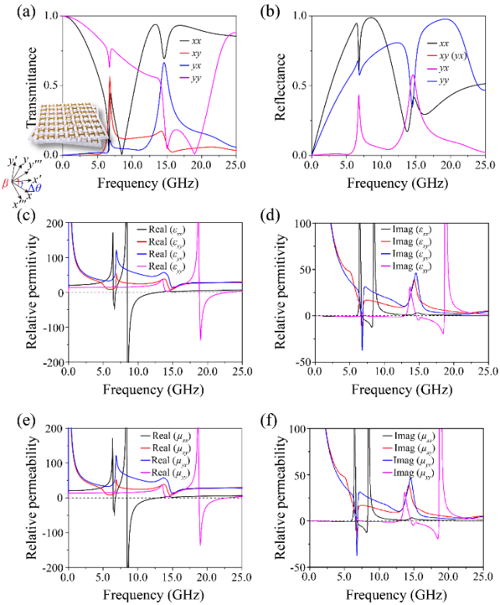Since the discovery of flat bands and unconventional superconductivity at the magic angle in twisted bilayer graphene by Cao et al., a variety of related exotic phenomena including correlated insulating states and ferromagnetism has been investigated. Analogous twistronic concepts have been extended to phonon and plasmon polaritons in layered low-dimensional photonic materials.
The moiré configurations provide a new platform for highly tunable and sensitive photonic responses, as their extremely enhanced light-matter interactions originate from the relative displacement or rotation angle in a staking bilayer or multilayer periodic array. However, previous findings are mostly focused on atomically-thin condensed matter, with limitations on the fabrication of multilayer structures and the control of rotation angles. Structured microwave moiré configurations are still difficult to realize.
To extend moiré physics to the terahertz and microwave regions, the cooperation research group led by associate Prof. Chunmei Ouyang from Tianjin University, associate Prof. Xiaoqiang Su from Shanxi Datong University, and Prof. Weili Zhang of Oklahoma State University designed a novel moiré configuration by stacking two mutually twisted hyperbolic metal-based metasurfaces, and the reported design exhibits unprecedented capability in the highly tunable and sensitive electromagnetic responses and magic angles. The research results are published in Photonics Research, Volume 10, No. 9, 2022 (Yi Liu, Chunmei Ouyang, Quan Xu, Xiaoqiang Su, Quanlong Yang, Jiajun Ma, Yanfeng Li, Zhen Tian, Jianqiang Gu, Liyuan Liu, Jiaguang Han, Yunlong Shi, and Weili Zhang. Moiré-driven electromagnetic responses and magic-angle in sandwiched hyperbolic metasurface [J]. Photonics Research, 2022, 10(9):1971).
Based on the effective medium theory and S-parameter retrieval process, the rotation matrix is introduced into the dispersion relation to analyze the underlying physical mechanism, where the permittivity tensor transforms from a diagonal matrix to a fully populated one whereas the permeability tensor evolves from a unit matrix to a diagonal one and finally becomes fully filled, so that the electromagnetic responses change drastically as a result of stacking and rotation.
As shown in Fig. 1, it is clear that the relative rotation between the two HMSs leads to non-diagonal components, which means that the topological transition frequencies and hyperbolic characteristics cannot be simply obtained based on the relative permittivity. Thus, the group obtain the EFCs of the moiré structure by analyzing the Fourier transform of the Ez distributions in the following part.

Fig. 1 Electromagnetic properties of the proposed moiré hyperbolic metasurface when Δθ = 15?.
As depicted in Fig. 2, the group find that the mode hybridization controlled by rotation enhances the electromagnetic response of the moiré pattern and achieves an effective modulation of the topological transition of the surface waves at different frequencies.
The fitted curve of the magic angles separating the closed (ellipse) and open (hyperbola) dispersion contours changes linearly with frequency, and the position of the magic angles can be found quantitatively by calculating the number of anti-intersection points between the moiré structure and the distinct layers. In addition, the spacer thickness dependence of the moiré structure is also discussed to further investigate the electromagnetic interaction of the moiré hyperbolic metasurface.

Fig. 2 Twist-induced topological transition of surface plasmons.
Finally, experimental measurements are implemented to verify the interesting twist-induced moiré effects, and the results are in good agreement with the simulations. The proposed twisted bilayer metasurface offers a new platform for manipulating light-propagation properties, thus being promising in nonlinear optics, near-field focusing, imaging, and showing exceptional capabilities in the design of plasmonic devices, multifunctional devices, and sensors.
Further research will be focused on the magnetic moiré configurations with lower propagation loss and multilayer structures with higher degree of freedom in photon response.


